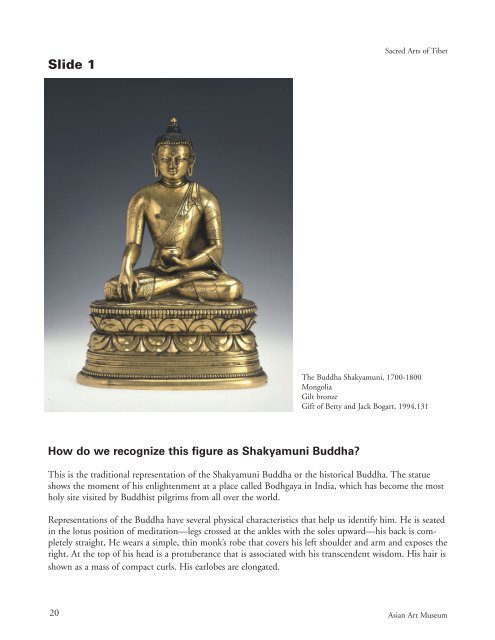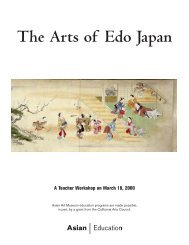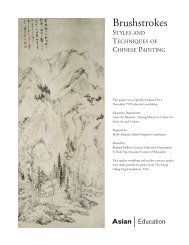Sacred Arts of Tibet (.pdf) - Asian Art Museum | Education
Sacred Arts of Tibet (.pdf) - Asian Art Museum | Education
Sacred Arts of Tibet (.pdf) - Asian Art Museum | Education
Create successful ePaper yourself
Turn your PDF publications into a flip-book with our unique Google optimized e-Paper software.
Slide 1<br />
<strong>Sacred</strong> <strong><strong>Art</strong>s</strong> <strong>of</strong> <strong>Tibet</strong><br />
The Buddha Shakyamuni, 1700-1800<br />
Mongolia<br />
Gilt bronze<br />
Gift <strong>of</strong> Betty and Jack Bogart, 1994.131<br />
How do we recognize this figure as Shakyamuni Buddha?<br />
This is the traditional representation <strong>of</strong> the Shakyamuni Buddha or the historical Buddha. The statue<br />
shows the moment <strong>of</strong> his enlightenment at a place called Bodhgaya in India, which has become the most<br />
holy site visited by Buddhist pilgrims from all over the world.<br />
Representations <strong>of</strong> the Buddha have several physical characteristics that help us identify him. He is seated<br />
in the lotus position <strong>of</strong> meditation—legs crossed at the ankles with the soles upward—his back is completely<br />
straight, He wears a simple, thin monk’s robe that covers his left shoulder and arm and exposes the<br />
right. At the top <strong>of</strong> his head is a protuberance that is associated with his transcendent wisdom. His hair is<br />
shown as a mass <strong>of</strong> compact curls. His earlobes are elongated.<br />
20<br />
<strong>Asian</strong> <strong>Art</strong> <strong>Museum</strong>
















